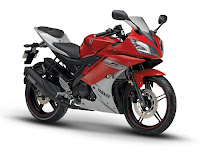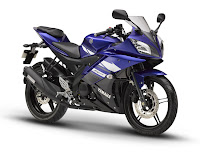Yamaha launches the first upgrade of its R15 model.. calls it Version 2.0
It's a cosmetic upgrade ok.. but it's "awesome"..!!
It was in Dec 2010 when the first "spy photos" of the upgrade of the Yamaha R15 had appeared on the net.
Since then it has been a rather long 10 months for Yamaha India to finally officially launch the upgrade of the Yamaha R15 which they are calling as Version 2.0
Since then it has been a rather long 10 months for Yamaha India to finally officially launch the upgrade of the Yamaha R15 which they are calling as Version 2.0

Throughout these 10 months it was amusing for me to see almost every desi auto-blog out there get hyper excited and post wild speculations like, "The power will be increased to 21-22 Ps (from the current 17Ps)..!!", or even "Price is expected to be reduced by Rs. 10,000..!!" to some smart ones claiming that it was the "European R125 & not a R15 upgrade"..!!
Why did the original R15 not get this design in 2008..??
Putting all wild speculations to rest, Yamaha India has officially launched the upgraded Yamaha R15 on Sep 6, 2011. As expected by me it is a cosmetic facelift (or is it "rear" lift?), the power output remains the same as the older model.
Usually I do not think much about cosmetic upgrades but this one is "sweet & awesome"..!!
Yamaha R15 Version 2.0 in a nutshell
Usually I do not think much about cosmetic upgrades but this one is "sweet & awesome"..!!
Yamaha R15 Version 2.0 in a nutshell
- Price: Rs. 1.07 lakhs (ex-showroom), an increase of around Rs. 8K-10K over the older model
- Kerb Weight: 136 Kgs (5 Kg increase over older model)
- Max. Power & Max Torque: 17 Ps Power and 15 Nm Torque (similar to the older model)
- Major changes in styling at the Rear of the bike
- Slight changes to the side panels and fairing
- A couple of other changes
Changes to the Rear of the bike
The most significant change is in the rear of the bike. The older bike was criticized by many including myself for its malnourished looking rear. Skinny rear tyre, commuterish rear seat.. et al. The rear of the version 2.0 is now probably the best looking among current Indian bikes. The changes at the rear include..
The most significant change is in the rear of the bike. The older bike was criticized by many including myself for its malnourished looking rear. Skinny rear tyre, commuterish rear seat.. et al. The rear of the version 2.0 is now probably the best looking among current Indian bikes. The changes at the rear include..

- Wider Rear Tyre: 130 mm wide now (compared to the 100 mm on the older model) also the rear tyre is now a Radial tyre
- A longer Swingarm made out of aluminum (compared to the simple rectangular swingarm on the older model)
- A longer Wheelbase (1345 mm compared to the 1290 mm of the older model)
- Split Seats which has a raised pillion seat
- LED tail lights (inspired from the R6)
- There are no grab rails on the bike now..!!
- A rear tyre hugger cum the mandatory saree guard
Other changes include
- Slightly redesigned fairing
- Redesigned side panels (with faux carbon fibre finish)
- New design alloy wheels
- New exhaust pipe with new heat shield (with R15 branding and faux carbon fibre finish)
- Seat height increase from 790 mm to 800 mm
- A larger 220 mm rear disc brake
Internal changes
- New Engine Control unit (ECU)
- New drive train (different sized front & rear sprockets) unit
- Double horns (the older model had a single meek sounding horn)

Photo Credit; xBhp.Com
Why did the original R15 not get this design in 2008..??
According to Yamaha India the aerodynamics on the new bike has improved by 4% (although I am not sure we would be able to measure it). The riding stance has become sportier compared to the earlier model (which was already sporty by Indian standards).
According to Yamaha India the aerodynamics on the new bike has improved by 4% (although I am not sure we would be able to measure it). The riding stance has become sportier compared to the earlier model (which was already sporty by Indian standards).
Even with the unchanged 17 Ps, the R15 Version 2.0 with its near "perfect looks" is a gem
Styling now stays true and honest to the "Super Sports" genre. Some might crib that the rear seat is now too raised and impractical/uncomfortable for pillion (grab rails has been done away with as well). But that's exactly how a bike with "Super Sports" intention should be.
I never bought the argument of Yamaha India in 2008 when it had stated that the rear portion of the R15 was made intentionally kept skinny (with a 100 mm rear tyre) so that it gave the best handling characteristics and the best performance. Had that been the case, then why bother giving the European R125 with a 130 mm wide tyre?
I am sure that even with the wider rear tyre, Yamaha would have taken care not to have compromised with the sharp handling of the new R15, something which had made the original R15 an enthusiasts delight.
I never bought the argument of Yamaha India in 2008 when it had stated that the rear portion of the R15 was made intentionally kept skinny (with a 100 mm rear tyre) so that it gave the best handling characteristics and the best performance. Had that been the case, then why bother giving the European R125 with a 130 mm wide tyre?
I am sure that even with the wider rear tyre, Yamaha would have taken care not to have compromised with the sharp handling of the new R15, something which had made the original R15 an enthusiasts delight.
Sharp handling = Good
Sharp Handling + Sexy Styling = Bloody Good..!!
Sharp Handling + Sexy Styling = Bloody Good..!!
Why did the original R15 get this design in 2008..?? Maybe because the CBR250R started happening in 2010 in India (finally launched in 2011).
Why not 19/21 Ps?
Expecting 19/21 Ps from a 150 cc engine, even if its a liquid cooled, 4 valve engine is a bit too optimistic. Those who might be disappointed with the lack of performance upgrade on the new R15, I am sure that even with the unchanged 17 Ps, the R15 Version 2.0 with it's near perfect looks would still a gem.
My take on the Yamaha R15 Version 2.0
The Yamaha R15 Version 2.0 might not be able to convince the Honda CBR250R customers change their decision but it might at least prevent the R15 intenders who might have started to think favorably towards the Honda CBR250R.
Why not 19/21 Ps?
Expecting 19/21 Ps from a 150 cc engine, even if its a liquid cooled, 4 valve engine is a bit too optimistic. Those who might be disappointed with the lack of performance upgrade on the new R15, I am sure that even with the unchanged 17 Ps, the R15 Version 2.0 with it's near perfect looks would still a gem.
My take on the Yamaha R15 Version 2.0
The Yamaha R15 Version 2.0 might not be able to convince the Honda CBR250R customers change their decision but it might at least prevent the R15 intenders who might have started to think favorably towards the Honda CBR250R.
Yamaha R15 Version 2.0 Colors:
 |  |  |
 |  |  |
Yamaha YZF-R15 version 2.0 Specifcations
Engine type: Liquid-cooled, 4-stroke, SOHC, 4-valve
Cylinder layout: Single cylinder
Displacement: 149.8cc
Bore × stroke: 57 × 58.7mm
Compression ratio: 10.4:1
Maximum output: 17 PS/ 8,500rpm
Maximum torque: 15 N.m / 7,500rpm
Starting method: Electric Start
Lubrication type: Wet Sump
Fuel tank volume: 12 liters
Fuel supply: Fuel Injection
Ignition type: T.C.I.
Battery: 12V, 3.5Ah (10H)
Head light: Lo beam12V/35W X1, Hi beam12V/35W X2
Primary / secondary reduction ratio: 3.042 / 3.133
Clutch type: Wet Multiple-disc
Transmission type: Return type 6-speed
Gear ratios: 1st=2.833, 2nd=1.875, 3rd=1.364, 4th=1.143, 5th=0.957, 6th=0.84
Frame type: Delta box
Caster / trail: 26° / 98mm
Tyre size (Front/ Rear): 90/80-17 / 130/70-R17
Brake type (Front/ Rear): Hydraulic, Single disc (Front / Rear)
Suspension (Front/ Rear): Telescopic / Linked type Monocross
Overall Length × Width × Height: 1,970mm x 670mm × 1,070mm
Seat height: 800mm
Wheelbase: 1,345mm
Minimum ground clearance: 160mm
Kerb Weight: 136Kg
0 comments:
Post a Comment